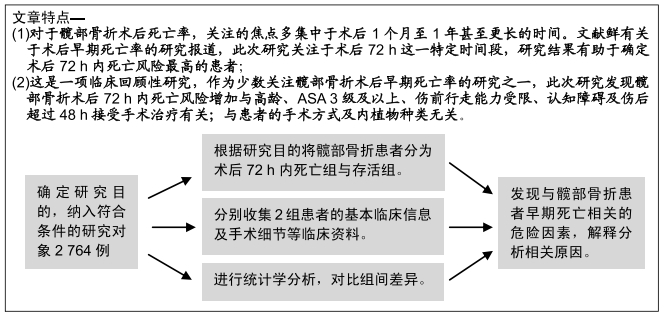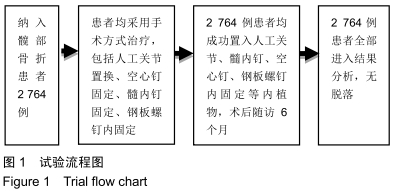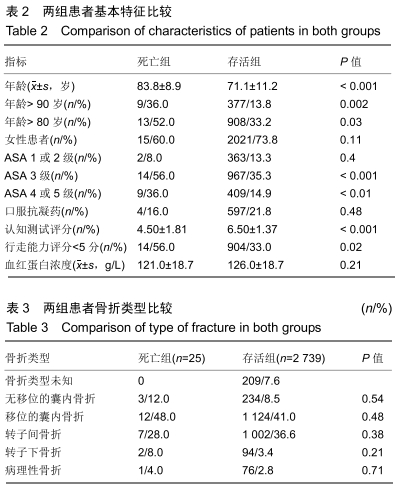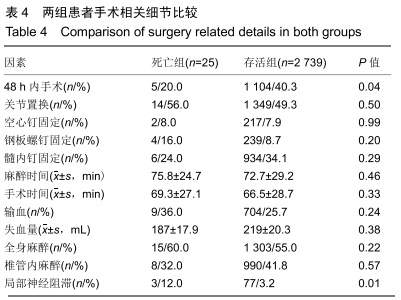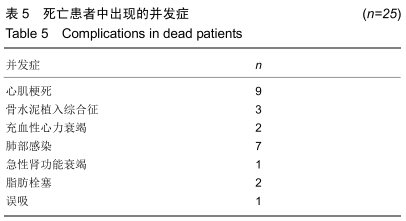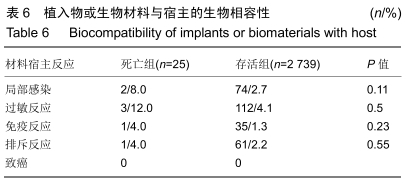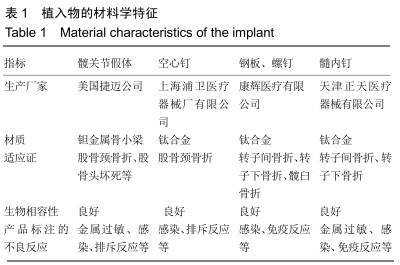[1] GULLBERG B, JOHNELL O, KANIS JA, et al. World-wide projections for hip fracture. Osteoporos Int. 1997;7(5): 407-413.
[2] 刘青春,陈云丰.手术时机与老年髋部骨折患者术后并发症发生及预后关系研究[J].创伤与急危重病医学,2018,6(4): 258-260.
[3] KANIS JA, ODEN A, MCCLOSKEY EV, et al. A systematic review of hip fracture incidence and probability of fracture worldwide. Osteoporos Int. 2012;23(9):2239-2256.
[4] 梁俊刚,李宝,张智海,等. FRAX软件评估北京地区中老年人骨折风险的预测价值[J].中国骨质疏松杂志,2019,25(6):762-767.
[5] 解冰,田竞,刘欣伟,等.常规髋臼手术入路联合大转子滑移截骨治疗复杂髋臼骨折疗效分析[J].创伤与急危重病医学,2017,5(2): 108-112.
[6] LUNDE A, TELL GS, PEDERSEN AB, et al. The role of comorbidity in mortality after hip fracture: a nationwide norwegian study of 38,126 women with hip fracture matched to a general-population comparison cohort. Am J Epidemiol. 2019;188(2):398-407.
[7] PARKER MJ, ANAND JK. What is the true mortality of hip fractures? Public Health.1991;105(6):443-446.
[8] REGUANT F, ARNAU A, LORENTE JV, et al. Efficacy of a multidisciplinary approach on postoperative morbidity and mortality of elderly patients with hip fracture. J Clin Anesth. 2018;53:11-19.
[9] JOHANSEN A, TSANG C, BOULTON C, et al. Understanding mortality rates after hip fracture repair using ASA physical status in the National Hip Fracture Database. Anaesthesia. 2017;72(8):961-966.
[10] PARKER MJ, PALMER CR. A new mobility score for predicting mortality after hip fracture. J Bone Joint Surg Br. 1993;75(5):797-798.
[11] QURESHI KN, HODKINSON HM. Evaluation of a ten-question mental test in the institutionalized elderly. Age Ageing. 1974;3(3):152-157.
[12] IRELAND AW, KELLY PJ, CUMMING RG, et al. Risk factor profiles for early and delayed mortality after hip fracture: analyses of linked australian department of veterans' affairs databases. Injury. 2015;46(6):1028-1035.
[13] 孙春生,李洪伟,郑欣,等.影响髋部骨折患者近期死亡的高危因素研究进展[J].中国矫形外科杂志,2018,26(10):930-933.
[14] 李兆光,刘智,孙天胜,等.老年髋部骨折术后1年死亡率及危险因素分析[J].北京医学,2015,37(11):1031-1035.
[15] STROMSOE K. Fracture fixation problems in osteoporosis. Injury. 2004;35(2):107-113.
[16] SIRCAR P, GODKAR D, MAHGEREFTEH S, et al. Morbidity and mortality among patients with hip fractures surgically repaired within and after 48 hours. Am J Ther. 2007;14(6): 508-513.
[17] CARRETTA E, BOCHICCHIO V, RUCCI P, et al. Hip fracture: effectiveness of early surgery to prevent 30-day mortality. Int Orthop. 2011;35(3):419-424.
[18] SEBESTYEN A, BONCZ I, SANDOR J, et al. Effect of surgical delay on early mortality in patients with femoral neck fracture. Int Orthop. 2008;32(3):375-379.
[19] DOWNEY C, KELLY M, QUINLAN JF, et al. Changing trends in the mortality rate at 1-year post hip fracture- a systematic review. World J Orthop. 2019;10(3):166-175.
[20] LEFAIVRE KA, MACADAM SA, DAVIDSON DJ, et al. Length of stay, mortality, morbidity and delay to surgery in hip fractures. J Bone Joint Surg Br. 2009;91(7): 922-927.
[21] KUMAR G. Protocol-guided hip fracture management reduces length of hospital stay. Br J Hosp Med (Lond). 2012;73(11): 645-648.
[22] GIANNOULIS D, CALORI GM, GIANNOUDIS PV, et al. Thirty-day mortality after hip fractures: has anything changed? Eur J Orthop Surg Traumatol. 2016;26(4): 365-370.
[23] 郭子刚,徐江波,袁宏.老年髋部骨折48小时绿色通道[J].中华骨质疏松和骨矿盐疾病杂志,2018,11(5):515-520.
[24] HEMPSALL VJ, ROBERTSON DR, CAMPBELL MJ, et al. Orthopaedic geriatric care--is it effective? A prospective population-based comparison of outcome in fractured neck of femur. J R Coll Physicians Lond. 1990; 24(1): 47-50.
[25] HO V, HAMILTON BH, ROOS LL, et al. Multiple approaches to assessing the effects of delays for hip fracture patients in the United States and Canada. Health Serv Res. 2000;34(7): 1499-1518.
[26] LEE GE, MUFFLY S, GOLLADAY GJ, et al. Management of Fragility Hip Fractures: Our Institutional Experience. Geriatr Orthop Surg Rehabil. 2019;10:1467887478.
[27] OZTURK I, TOKER S, ERTURER E, et al. Analysis of risk factors affecting mortality in elderly patients (aged over 65 years) operated on for hip fractures. Acta Orthop Traumatol Turc. 2008;42(1):16-21.
[28] PRODOVIC T, RISTIC B, RANCIC N, et al. Factors influencing the six-month mortality rate in patients with a hip fracture. Zdr Varst. 2016;55(2):102-107.
[29] JOHAL KS, BOULTON C, MORAN CG, et al. Hip fractures after falls in hospital: a retrospective observational cohort study. Injury. 2009;40(2):201-204.
[30] LIU Y, WANG Z, XIAO W, et al. Risk factors for mortality in elderly patients with hip fractures: a meta-analysis of 18 studies. Aging Clin Exp Res. 2018;30(4):323-330.
[31] AHMAN R, SIVERHALL PF, SNYGG J, et al. Determinants of mortality after hip fracture surgery in Sweden: a registry-based retrospective cohort study. Sci Rep. 2018;8(1): 15695.
[32] CHATTERTON BD, MOORES TS, AHMAD S, et al. Cause of death and factors associated with early in-hospital mortality after hip fracture. Bone Joint J. 2015;97-B(2):246-251.
[33] PUCKERIDGE G, TERBLANCHE M, WALLIS M, et al. Blood management in hip fractures; are we leaving it too late? A retrospective observational study. BMC Geriatr. 2019;19(1): 79.
[34] WEI J, ZENG L, LI S, et al. Relationship between comorbidities and treatment decision-making in elderly hip fracture patients. Aging Clin Exp Res. 2019.
[35] AL KA, AL-HADEEDI O, SAYANA MK, et al. Withholding clopidogrel for 3 to 6 versus 7 days or more before surgery in hip fracture patients. J Orthop Surg (Hong Kong). 2013;21(2): 146-150.
[36] KHAN MA, HOSSAIN FS, AHMED I, et al. Predictors of early mortality after hip fracture surgery. Int Orthop. 2013;37(11): 2119-2124.
[37] DODD AC, BULKA C, JAHANGIR A, et al. Predictors of 30-day mortality following hip/pelvis fractures. Orthop Traumatol Surg Res. 2016;102(6): 707-710.
[38] SMITH T, PELPOLA K, BALL M, et al. Pre-operative indicators for mortality following hip fracture surgery: a systematic review and meta-analysis. Age Ageing. 2014;43(4): 464-471.
[39] KATSANOS S, MAVROGENIS AF, KAFKAS N, et al. Cardiac Biomarkers Predict 1-Year Mortality in Elderly Patients Undergoing Hip Fracture Surgery. Orthopedics. 2017;40(3): e417-e424.
[40] LV H, YIN P, LONG A, et al. Clinical characteristics and risk factors of postoperative pneumonia after hip fracture surgery: a prospective cohort study. Osteoporos Int. 2016;27(10): 3001-3009.
[41] KHAN MA, HOSSAIN FS, AHMED I, et al. Predictors of early mortality after hip fracture surgery. Int Orthop. 2013;37(11): 2119-2124.
[42] HAHNEL J, BURDEKIN H, ANAND S, et al. Re-admissions following hip fracture surgery. Ann R Coll Surg Engl. 2009; 91(7):591-595.
[43] OMARI A, MADSEN CM, LAURITZEN JB, et al. Comorbidity and mortality after hip fracture in nineteen thousand six hundred and eighty two patients aged eighteen to sixty five years in Denmark from 1996 to 2012. Int Orthop.2019;43(11): 2621-2627.
[44] CHA YH, LEE YK, KOO KH, et al. Difference in Mortality Rate by Type of Anticoagulant in Elderly Patients with Cardiovascular Disease after Hip Fractures. Clin Orthop Surg. 2019;11(1):15-20.
|
